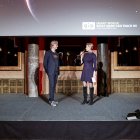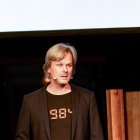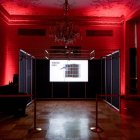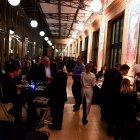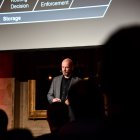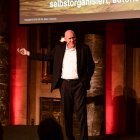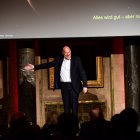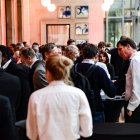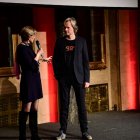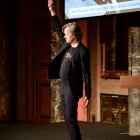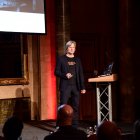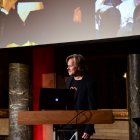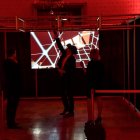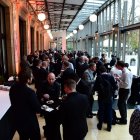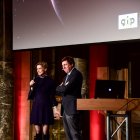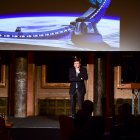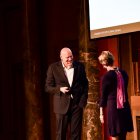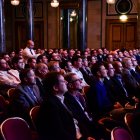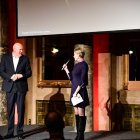2018 – Que Sera! Smart World: What Mars Can Teach Us.
13. Xyna Conference 21.11.2018 at the Kurhaus, Wiesbaden
Learning from Mars for Earth
13th Xyna conference looks at Mars colonies, digitized construction and decentralized power supply
Mainz/Wiesbaden - What could human life on Mars look like - and what can we learn from such a scenario for our world today? Under the motto "Que sera, Smart World - What Mars can teach us", this year's Xyna conference of the Mainz-based GIP Research Institute took place on November 21, 2018. More than 270 guests, mainly from the telecommunications and IT industries, met at the Wiesbaden Kurhaus to discuss related issues. "The extreme requirements for human life on Mars are an incentive to think radically about innovative software and IT solutions for Earth," said GIP board member Dr. Bernd Reifenhäuser, describing his motivation. Prominent ex-astronaut Ulrich Walter provided impulses on the topic.
Scientific astronaut Prof. Dr. Ulrich Walter enthused the audience.
"The Future of Humanity in the Cosmos and How We Can Live on Mars".
Colonies in space
Ulrich Walter, now Professor of Astronautics at the Technical University of Munich, gave the audience a fascinating outlook on the future of man in space. In his view, there are two reasons for colonizing Mars: The search for evidence of life and the use of Mars as a stepping stone for further colonization of space. Because our neighboring planet is extremely cold and its atmosphere contains no oxygen, human settlers would have to live under hermetically sealed domes in an initial phase. "Research is already underway on methods to extract oxygen and fuel from the Martian soil for such settlements," Walter explained. But settlers, the space scientist said, would not want to live permanently under domes, but would want to move freely around the planet.
Therefore, in a second phase, one would begin to transform Mars into a planet that is life-friendly for humans through so-called "terraforming." Researchers have already developed concrete plans for this. First, a powerful greenhouse gas (perfluorocarbon) would be introduced into the Martian atmosphere. This would warm up and cause large quantities of frozen carbon dioxide, which is stored at the Martian poles, to change into a gaseous state. After about 40 years, Mars would have an atmosphere of pure carbon dioxide - also a greenhouse gas that would continue to drive warming. About 100 years later, the temperature would have risen to 0 degrees Celsius, and ice found in the Martian soil would thaw. The water could be used to grow plants, which in turn would produce enough oxygen over the course of 500 or 1000 years for humans to breathe Martian air. In a few thousand years - according to the vision of some scientists - there could even be cities on Mars.
From Mars, humans could eventually set out to colonize planets outside our solar system. However, future settlers would have to limit themselves to our own galaxy, because all others are too far away. But even within our galaxy, the journey to another star would take several hundred years. According to Walter, such distances could be overcome - for example, in 30-kilometer-long "generation ships" that could accommodate entire cities.
Big rush on the Xyna Holo Deck.
Mars Habitat Modelling in Virtual Environment
Digitalized construction
From the distant future, the next lecture brought us back to the present. "Digital Design and Manufacturing" was the topic of Klaus Teltenkötter, architect and professor of digital design at Mainz University of Applied Sciences. He reported on enormous advances that have taken place in this field in recent years. Robots could now brick houses, and do so without pause, while being more individual and precise than humans. "The robot can already build houses even where you yourself don't want to go until later," Teltenkötter said, referring to a possible settlement on Mars. Some experts believe that in as little as 15 years, building with robots will become the industry standard. Computer-controlled drones could also change construction. At the Swiss Federal Institute of Technology in Zurich, scientists are currently experimenting with drones that build bridges in a swarm.
The digital transformation in the construction industry will also be helped by so-called 3-D printers - computer-controlled devices that apply a material layer by layer to create three-dimensional objects. Large-format devices of this kind are now being used to build houses from a variety of materials, such as clay or straw-based raw materials. 3-D printers, Teltenkötter said, could also contribute to the upcycling of plastic waste by using plastics shredded into small pieces as the starting material for new objects. Digitization is also changing the external shape of houses, he said, which - if designed by computer - would turn out round rather than square. "Completely new possibilities are currently emerging in the field of digital design and construction," Teltenkötter summarized.
Full house
It was an honor to welcome so many great guests.
Martian power supply
From the thought experiment of a Martian settlement, GIP president Dr. Bernd Reifenhäuser derived requirements for a power supply system suitable for Mars. "Reduce to the max" is the guiding principle here: the system would have to consume little energy, function without being connected to a terrestrial data center, and be autonomous, self-organized and intelligent. It would have to contain sensors that guarantee high data quality, actuators, especially power electronics, sufficient computing power and the ability to communicate with the various components.
The decentralized power grid "Quantum Grid" developed by GIP meets all these requirements. Analogous to the Internet, small power packets here find their way through the lines independently - even in areas with different voltage or frequency. Special routers are located at certain network nodes in the Quantum Grid that link subnetworks with the same voltage and frequency to other areas. Because the Quantum Grid no longer requires central control, it would be open to even the smallest energy producers. "On Mars, this could be solar panels on the ground or satellites that send down energy by laser or microwave," Reifenhäuser explained.
On Earth, such a network would be ideal for regions where there are hardly any reliable power grids, for example in Africa. Under the motto "Martian Digitalization," the GIP Research Institute is currently setting up a future laboratory in which the power supply of the future will be simulated and tested.
In his closing presentation, Dr. Alexander Ebbes, Vice President of the GIP Research Institute, introduced a new GIP platform called Xyna Phi.
The GIP was on Mars 5 days before NASA!
Holodeck to Mars: 21.11.2018 // Mars InSight Mission: 26.11.2018
Mars in the holodeck
Between the sessions, visitors had the opportunity to move around a virtual world on Mars in a so-called "holodeck" - the name comes from the science fiction series Star Trek. With the data goggles on their heads, the visitors dived deep into the Martian reality and were able to change it themselves. Using a special tool, visitors were able to design their own habitat out of Martian rock. It was also possible to "beam" to three different locations on Mars. The holodeck, originally developed as part of a research project at Mainz University of Applied Sciences, was very well received and was constantly besieged by visitors.
Various workshops, including a creative workshop on the topic of "Smart World 2050", completed the program, which ended in the evening with the traditional Xyna party.
Xyna Conference 2018 Agenda & Speakers

14:00 – 14:30
Dr. Bernd Reifenhäuser
President, GIP Research Institute
Smart World: Was können wir vom Mars lernen um mit smarten Technologien für die Heißzeit gewappnet zu sein?
14:30 – 15:00
Prof. Dr. Ulrich Walter
Science Astronaut, TU Munich
Die Zukunft der Menschheit im Kosmos und wie wir auf dem Mars leben können
15:00 – 17:00
Xyna Café
Xyna Holo-Deck: Virtual visit to Mars: build your own habitat! // Xyna Demos // Meet Prof. Dr. Ulrich Walter // Ideas Conference // coffee & cake
17:00 – 17:30
Prof. Klaus Teltenkötter
Mainz University of Applied Sciences
Digitalisierung im Bereich der Gestaltung
17:30 – 18:00
Dr. Alexander Ebbes & Dr. Bernd Reifenhäuser
GIP Exyr GmbH
Xyna Phi for a Smart World
18:00
Xyna Party
Dinner-Buffet & Drinks @ Xyna Holo-Deck
XK2018 Review - Video
A review of the Xyna Conference 2018 of the GIP Research Institute on 21.11.2018 at the Kurhaus, Wiesbaden.
If you want to watch embedded videos on this page, personal data (IP address) will be sent to the operator of the video portal (here youtube.com) and cookies will be set on your device. Therefore, it is possible that the video provider stores your accesses and can analyze your behavior. By clicking on "PLAY VIDEO" you consent to the data processing and the setting of cookies.
For more information on data protection, click here: Data Protection
Play VideoBreaking news:
First xyna.bio Hackathon
Last Friday, xyna.bio hosted a highly successful hackathon, bringing together motivated students and industry experts to work on cutting-edge biotech solutions using our first beta version. We are thrilled to share the highlights and achievements from this inspiring event. Participants tackled ambitious projects, including optimizing a protein involved in plastic degradation and designing a synthetic serotonin-like molecule for Alzheimer's disease treatment. With our initial pipeline, teams were able to design workflows from scratch and present initial results within just a few hours, showcasing the powerful capabilities of xyna.bio. One of the standout achievements was the integration of a ChatGPT node by the students, demonstrating the innovative potential of combining AI with biotech. We are excited to announce that we will be pursuing the addition of this ChatGPT node into the first official version of xyna.bio, set to launch later this year. Stay tuned for more updates on this exciting development!
Read moreMonday, July 8, 2024More latest articles:
xyna.bio @BFH iGEM Meetup Bielefeld
We had the incredible opportunity to participate in the BFH European iGEM Meetup and lead a workshop on leveraging AI in bioscientific research, showcasing our solution xyna.bio. We were overrun by motivation and eagerness, with our workshop being among the most signed up for among the 150 participants! Our mission to empower bioscientists with xyna.bio struck a nerve with everyone around, showcasing the need for an innovative way to integrate wet and dry lab processes and automate complex bioinformatical analysis for the scientists that need it. Read the full story here: https://www.linkedin.com/posts/xollx-futurelab_we-had-the-incredible-opportunity-to-participate-activity-7203402023600275457-Rz5P?utm_source=share&utm_medium=member_desktop
Read moreWednesday, May 29, 2024Great success on jumpstarting with the first Future on Site event – Next GenAI goes Bio!
Our new series Future on Site jumpstarted with an inspiring mixture of young scientists coming together to create future synthetic biology solutions. The eagerness to develop new algorithmic tools and solve modern problems of our local iGEM Teams is fascinating, gaining them each a XOLLX iGEM Grant prize to develop their projects. A highlight was the firsthand insight, invaluable for the development of our Saturn project derived xyna.bio. The idea of an AI-aided bioinformatical analysis hyperautomation platform was greeted by all with enthusiastic discussions and ideas. The shared vision among all at the Future on Site: Next GenAI goes Bio once again showed the great innovative potential that we are eager to harness in these interdisciplinary events. Thank you again to everyone from the iGEM Tübingen, iGEM Aachen, iGEM Frankfurt and CompuGene Student Lab for the amazing first Future On Site Event. We will persist in gathering innovative minds to further work on creating our future.
Read moreMonday, May 13, 2024XOLLX iGEM Grant 2024 winners
Inspiring project teasers presented during our Future On Site event by local iGEM Teams – which convinced the XOLLX Lab to support the 3 iGEM groups with the first round of the XOLLX iGEM Grant awards! Congratulations to… iGEM Frankfurt – with their innovative synthetic design for sustainable solution towards keep our skin safe from sun exposure and the coral reefs safe from our toxic sunscreen ingredients iGEM Aachen – with a tumor microbiome targeting prodrug system next to more than one amazing software project to educate future scientists iGEM Tübingen – with a step towards a modular construction kit of molecular biosensors for a spectrum of applications We are excited to see and support your project developments in the upcoming months towards Paris!
Read moreFriday, April 12, 2024

